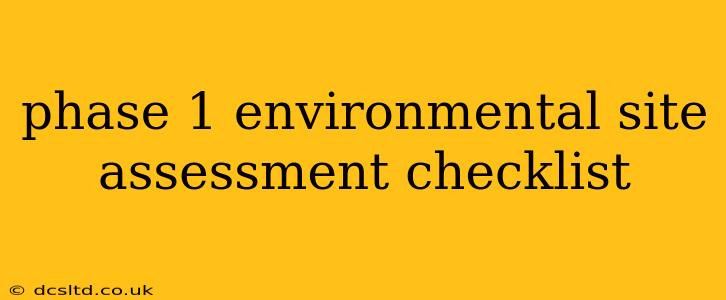Phase I Environmental Site Assessment Checklist: A Comprehensive Guide
A Phase I Environmental Site Assessment is the first step in determining the environmental condition of a property. It's a crucial process for anyone involved in real estate transactions, development, or refinancing, helping to identify potential environmental liabilities. This checklist provides a comprehensive overview of the key components involved in conducting a thorough Phase I ESA. Remember, this checklist is for informational purposes and should not replace professional advice from a qualified environmental consultant.
What is a Phase I Environmental Site Assessment?
A Phase I ESA is a non-invasive investigation that involves a review of historical records and a site reconnaissance to identify potential environmental contamination. It follows the ASTM E1527-13 standard (or equivalent) and aims to identify Recognized Environmental Conditions (RECs). RECs are conditions indicating past releases of hazardous substances. This assessment doesn't involve digging or soil sampling; that's left for Phase II investigations.
Key Components of a Phase I Environmental Site Assessment Checklist:
I. Historical Records Review:
- Property Ownership History: Trace the ownership chain to identify past uses of the property. This often involves searching county records, tax assessor's offices, and potentially state archives.
- Aerial Photographs: Analyze aerial photos from different time periods to visually identify potential sources of contamination (e.g., old landfills, underground storage tanks).
- Sanborn Maps: Detailed historical maps that can reveal past building structures and industrial activities.
- Title Records and Deeds: Check for any mentions of environmental issues, easements, or covenants.
- Environmental Databases: Search databases like the EPA's Envirofacts, state environmental databases, and potentially the Brownfields database to discover reported releases or contamination incidents.
- Local Government Records: Review building permits, zoning records, and other local government documents.
- Interviews with Past Owners or Occupants: Gather information from anyone with knowledge of the property's history.
II. Site Reconnaissance:
- Visual Inspection of the Property: Conduct a thorough walkthrough of the property to identify visible signs of contamination (e.g., staining, leaking tanks, unusual vegetation).
- Observation of Surrounding Properties: Note adjacent properties and their potential for impacting the target site.
- Identification of Potential Sources of Contamination: Document any observed potential sources, such as underground storage tanks (USTs), waste disposal areas, or previous industrial activities.
- Photography: Take detailed photographs to document the site conditions and any potential issues.
- Site Measurements and Mapping: Create a site map showing the location of all observed features and potential sources of contamination.
III. Report Preparation:
- Executive Summary: Concise overview of the assessment findings.
- Site Description: Detailed description of the property, including location, size, and surrounding areas.
- Historical Information: Summary of the historical records review.
- Site Reconnaissance Summary: Description of the visual inspection and observations.
- Environmental Concerns: Identification of any RECs or potential environmental concerns.
- Conclusions and Recommendations: Summary of the findings and recommendations for further investigation, if needed.
- Appendices: Include supporting documentation, such as photographs, maps, and search results.
Frequently Asked Questions (PAAs):
1. What are the limitations of a Phase I ESA?
A Phase I ESA is limited by the available historical records and the non-invasive nature of the investigation. It cannot guarantee the absence of contamination, but rather identifies potential sources and areas of concern. Subsurface investigation (Phase II) is often necessary to confirm the presence or absence of contamination.
2. Who needs a Phase I Environmental Site Assessment?
Anyone involved in real estate transactions (buying, selling, or refinancing), development projects, or other activities involving property use should consider conducting a Phase I ESA. It helps to protect against potential environmental liabilities.
3. How long does a Phase I ESA take?
The timeline varies depending on the complexity of the site and the availability of historical information. It can range from a few weeks to several months.
4. How much does a Phase I ESA cost?
The cost depends on various factors, including the site's size, complexity, and location. Costs can range significantly from several hundred to several thousand dollars.
5. What happens if a Recognized Environmental Condition (REC) is identified?
If a REC is identified, further investigation (Phase II) is usually required to assess the extent and nature of the contamination. Remediation may be necessary depending on the findings of the Phase II ESA.
This checklist provides a starting point for conducting a Phase I Environmental Site Assessment. It is crucial to engage a qualified environmental consultant experienced in conducting Phase I ESAs according to ASTM E1527-13 (or equivalent) standards to ensure a thorough and legally defensible assessment. This information is for general knowledge and does not constitute legal or environmental advice. Always seek professional guidance for your specific situation.
